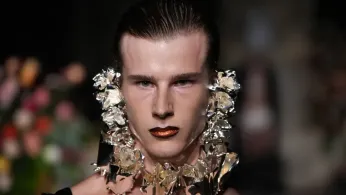
6 hours ago
Palomo Spain: Reimagining Queer Fashion Through Divine Subversion
READ TIME: 3 MIN.
In the ever-evolving world of fashion, queer designers have consistently led the charge in challenging conventions and expanding the boundaries of self-expression. Among the current vanguard, Alejandro Gómez Palomo, founder of *Palomo Spain*, stands out for his fearless integration of queer narratives, Spanish heritage, and avant-garde aesthetics. Palomo Spain’s latest collection, “All of Heaven’s Parties,” debuted for Spring/Summer 2025 and has quickly become a touchstone for those tracking the cultural pulse of LGBTQ+ communities worldwide .
Palomo Spain’s 2025 collection poses a provocative question: why are intrinsic emotions such as lust and desire so often perceived as sinful? Palomo uses fashion as a platform to imagine queer joy and longing as sacred, not taboo. The collection was staged in a cathedral, a deliberate choice that juxtaposed ecclesiastical grandeur with sensual, gender-fluid garments. This interplay invited audiences to reconsider traditional boundaries between the holy and the profane, the masculine and the feminine, and the personal and the communal.
The garments themselves feature flowing silhouettes, intricate embroidery, and bold color palettes inspired by southern Spain. Palomo’s signature style—blending elements typically coded as “masculine” and “feminine”—is evident in every piece. Velvet capes, sheer blouses, and ornate gowns appear alongside sharply tailored suits, each item serving as a testament to the designer’s commitment to inclusivity and fluidity .
Alejandro Gómez Palomo hails from Posadas, a village in southern Spain, and cites his upbringing as a major influence on his aesthetic. His collections often pay homage to Spanish folklore, religious iconography, and the theatricality of flamenco—all reframed through a queer lens. Palomo’s time studying in London further broadened his approach, introducing him to international queer subcultures and cementing his belief in fashion as both political and personal .
Palomo Spain’s rise to prominence is emblematic of a new era, where LGBTQ+ designers are celebrated not merely as muses but as auteurs. His work has garnered acclaim from global icons, with celebrities and musicians alike donning Palomo’s creations on red carpets and stages worldwide. This visibility amplifies queer artistry on an international scale, challenging the industry’s historic marginalization of LGBTQ+ voices .
Beyond the runway, Palomo Spain embodies the communal spirit of queer culture. The brand’s shows are more than fashion events—they serve as rituals that foster connection, joy, and resistance within LGBTQ+ communities. By choosing venues like cathedrals and incorporating elements of pageantry and performance, Palomo reclaims spaces often associated with exclusion, transforming them into sites of queer celebration and affirmation.
This approach echoes broader trends in the fashion world, where LGBTQ+ designers are increasingly foregrounding community and activism. From fundraising for mental health services to advocating for inclusive casting and representation, queer creators are reshaping the industry’s priorities .
What sets Palomo Spain apart is its ability to weave personal history, political commentary, and aesthetic bravado into a unified vision. By channeling queer narratives through the language of high fashion, Alejandro Gómez Palomo crafts garments that are both wearable and revolutionary. Each collection sparks conversations about identity, desire, and belonging, reflecting the lived realities of LGBTQ+ people while inviting the broader public to engage with their stories .
As queer designers like Palomo continue to gain recognition, they are not only shaping fashion’s future but also influencing the cultural and social landscape at large. Their work challenges audiences to envision a world where self-expression is limitless and where the boundaries between art, ritual, and identity are gloriously blurred.






